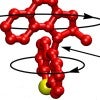
Bacteria-killing drills get an upgrade
Rice scientists have created light-activated molecular drills that can kill antibiotic-resistant bacteria.

Bacteria-killing drills get an upgrade
Rice scientists have created light-activated molecular drills that can kill antibiotic-resistant bacteria.

Rice ‘metalens’ could disrupt vacuum UV market
Rice photonics researchers have created a potentially disruptive technology for the ultraviolet optics market.
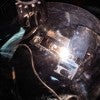
Graphene gets enhanced by flashing
Rice University scientists who developed the flash Joule heating process to make graphene have found a way to produce doped graphene to customize it for applications.

Rare earth elements await in waste
Rice University scientists applied their flash Joule heating process to coal fly ash and other toxic waste to safely extract rare earth elements essential to modern electronics and green technologies.

People, papers and presentations for Jan. 18, 2022
Rice chemist James Tour is among 32 investigators in five countries who will collaborate on the “Mend the Gap!” project to heal spinal cord injuries.

Nanotube fibers stand strong -- but for how long?
A Rice University study calculates how cyclic strain and stress affects nanotubes and describes how fibers under cyclic loads can fail over time.

People, papers and presentations for Nov. 22, 2021
People, papers and presentations for Nov. 22, 2021
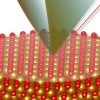
Magnetene’s ultra-low friction explained
Rice scientists help make the first measurements of ultra-low friction in 2D magnetene.

Weak bonds a strength in making borophene
Rice University researchers show how borophene, the 2D form of boron, can be grown to simplify its use for applications.
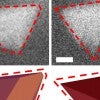
This pyramid scheme could be helpful
Rice chemists uncover the mechanism behind controlled growth of gold tetrahedron nanoparticles using liquid cell transmission electron microscopy.
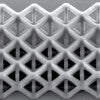
Nanoscale lattices flow from 3D printer
Rice University engineers are printing 3D lattices of glass and crystal with sub-200 nanometer resolution. The technique could make it practical to print micro-scale electronic, mechanical and photonic devices.

Corps of Engineers funds bid to ‘flash’ waste into useful materials
A $5.2 million U.S. Army Corps of Engineers grant will expand Rice efforts to recycle waste into valuable products through flash Joule heating.

National 2D materials research center wins NSF funding
Rice, Penn State and Boise State have won a federal grant to expand ATOMIC, a national research center that develops atom-thin 2D coatings via university, industry and government partnerships.
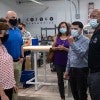
DesRoches, Nakhleh, others tour startup Syzygy Plasmonics
Rice's provost, dean of engineering and others toured chemical manufacturing startup Syzygy Plasmonics last week.

NSF grant kicks off Center for Adapting Flaws into Features
Rice University has won a Phase I National Science Foundation grant to establish the NSF Center for Adapting Flaws into Features to investigate nanoscale chemical phenomena and optimize the structures and electronic properties of materials.